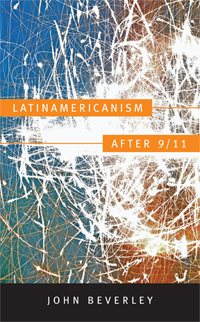A Review of John Beverley’s Latinamericanism after 9/11
Click here for Spanish text/ Clic aqui para leer en español
by Emilio del Valle Escalante (Maya k’iche’, iximulew)
In the wake of the September 11 attacks on U.S. soil in 2001, Latin American nation-states united behind George W. Bush’s policies toward denying “terrorist groups the capacity to operate in this Hemisphere.”1 Through the Organization of American States Bush stated: “This American family stands united” (Youngers, 151). However, instead of nurturing this support, the Bush administration turned its back on Latin America and launched a “war on terror” in the Middle East (particularly Iraq) that ignited a long and divisive conflict whose consequences are still felt today, particularly with the emergence of the Islamic State of Iraq and Syria (ISIS). U.S. distancing from Latin America, some have argued, led to the emergence of Left-leaning politics that through democracy have taken control of the nation-state, a phenomenon that is known as the Marea rosada or “Pink Tide” politics. Indeed, after September 11, 2001, we see the establishment of the governments of the late Hugo Chávez in Venezuela, Luis Inácio Lula da Silva in Brazil, Evo Morales in Bolivia, Rafael Correa in Ecuador, Cristina Fernández in Argentina, and Daniel Ortega in Nicaragua, governments that mark a transition from neoliberal capitalist economies to “socialist” oriented ones.
Taking this context as a point of departure, John Beverley’s Latinamericanism after 9/11 explores the significance of the Marea rosada governments for Latin American studies, arguing that these Left-leaning governments open up a “new, unforeseen, and unforeseeable series of possibilities and determinations.”2 With their bet on socialism, these governments mark a decline of the Washington Consensus in the region and a shift away from identification with U.S. power. Beverley sees these political processes as unfolding a necessary confrontation between Latin America and the United States that provides an opportunity to redefine and assert Latinamericanism’s “ideological and geopolitical force” (Beverley, 7). The book includes an Introduction and seven chapters where Beverley engages in discussions and debates with various sectors of the Latinamericanist intelligentsia in order to re-examine, conciliate, transcend and establish a new critical “post-subalternist” framework that validates the nation-state as a site of struggle and proposes a “new” Latinamericanism that in its engagement with social movements can potentially lead to political and social change (Beverley, 15).
In the chapters “Latinamericanism after 9/11” and “Between Ariel and Caliban,” Beverley maps the debates between Latinamericanists who claim to speak from Latin America and those who speak of Latin America outside its geopolitical boundaries. In these chapters, he develops a critique of neo-Arielist intellectuals like Mabel Moraña, Hugo Achugar, and Nelly Richard who propose a critical stance that instead of embracing the new politics and demands of social movements, seem more interested in rearticulating a form of critique that values high culture and the authority of the criollo-mestizo intellectual as a carrier of knowledge and cultural memory.3 Neo-Arielist arguments against Latin Americanists in the U.S., according to Beverley, have three components: 1) Latin American studies from the U.S. concentrate on identity politics and multiculturalism, discussions that have been “transferred” to Latin America and misrepresent diverse histories and social-cultural formations; 2) Latin American Studies occludes the prior engagement by Latin American intellectuals on “native grounds,” and in doing so, they subalternize the contributions of thinkers from Latin America; 3) theoretical frameworks such as Subaltern and Postcolonial Studies from the North contribute to diminish Latin America’s ability to implement its own projects of national or regional identity and development (Beverley, 62-63)
Beverley points out that by constructing an argument that situates Latin America against Latinamericanists in the United States and other parts of the world, neo-Arielists offer an inadequate response to cultural and economic U.S. hegemony. By claiming to speak “from” Latin America, or “on the ground,” these intellectuals not only overlook the orientalization that operates within the Latin American lettered city, but also reassert their own cultural and political authority and that of literature and literary criticism (Beverley, 61). In doing so, they end up reaffirming their own criollo-mestizo European origins and bourgeois or middle class status and articulate a discursive position incapable of producing a “national-popular appeal”(Beverley, 20) Instead, Beverley proposes a new form of Latinamericanism that recovers the “space of cultural dehierarchization ceded to the market and neoliberalism” and is “capable of both inspiring and nourishing itself from new forms of political and social practice from below” (Beverley, 22-23). This would entail recognizing the multiethnic and multinational nature of Latin America, the demands of Latin American social movements and the populations threatened by globalization and neoliberalism, the forms of territoriality that go beyond the nation-state (e.g. Hispanics in the United States), the struggles against male chauvinism, racism, homophobia, and those of women and sexual minorities for gender equality (Beverley, 24). Given that all of these demands and struggles are constitutive of Latin America itself, it is now time, Beverley argues, to develop critical approaches that can incorporate these populations’ demands in order to affirm Latin America as its own civilizational project, “capable of confronting U.S. hegemony and expressing an alternative future for the peoples of the Americas” (Beverley, 18).
In the third chapter, entitled “The Persistence of the Nation,” Beverley offers a critique of Michael Hardt and Antonio Negri’s Empire (2001). Since Hardt and Negri argue that we live in a sort of Roman Empire where there is no “center” and/or “periphery,” Beverley asks: who in the world today represents a logic of resistance that can bring down Empire and propose alternatives to its logic? Beverley’s critique concentrates on Hardt and Negri’s idea of the “multitude” by which they mean the “many-faced, hydra-headed, hybrid collective subject conjured up by globalization and cultural deterritorialization” (Beverley, 26-27). For Beverley, however, the multitude is an expanded way of naming the proletariat as a hybrid or heterogeneous and “universal” subject that dismisses the specific demands—many times nationalistic—of the subaltern. For example, the social movements that Hardt and Negri themselves evoke, like the Zapatistas in Chiapas, or the Intifada in Palestine, are characterized by identity politics and the necessity to change the nature of the nation-state. Hardt and Negri want to imagine—Beverley indicates—a form of “politics that would go beyond the limits of both the nation and the forms of political and cultural representation traditionally bound up with the idea of hegemony” (Beverley, 27-28).
In chapter four, “Deconstruction and Latinamericanism,” Beverley concentrates on Alberto Moreiras’s The Exhaustion of Difference which he reads as a “new” form of Latinamericanism that uses deconstruction as a theoretical framework capable of renewing “if not the Left in a traditional sense, then certainly an emancipatory politics to come in the emerging new world order of globalization” (Beverley, 44-45). Moreiras, according to Beverley, is concerned with the politics of knowledge involved in the representation of Latin American culture, and aims “to bring into crisis and radicalize the ideological and conceptual space of Latin American cultural studies” (Beverley, 45). Given that Moreiras depends on the appropriation and privileging of certain kinds of knowledge (usually that of high culture, or the baroque), like the neo-Arielists, he ends up re-signifying the authority of the intellectual, failing to interrogate his own critical position and authority, as well as other forms of subaltern knowledge that fall outside the metropolitan Latinamericanism he proposes. In this sense, Moreiras articulates a critical space of cosmopolitan critical theory “which is itself produced by and feeds back into the logic of globalization” (Beverley, 54).
In “The Neoconservative Turn,” Beverley sees that alongside the re-emergence of the Left as a political force after 9/11, there is also a critical tendency within the Latin American Left that “is characterizing itself, or turning ‘conservative’ in cultural matters but ‘liberal’ in political and economic ones” (Beverley, 91). This critical tendency, similar to neo-Arielism and deconstruction, is represented by a middle- and upper-middle-class, university-educated, and what is essentially a white, Criollo-Ladino/Mestizo intelligentsia that attempts to recapture “the space of cultural and hermeneutic authority” (Beverley, 93). This intellectual class is exemplified by, among others, Mario Roberto Morales, Mabel Moraña and Beatriz Sarlo who develop critiques, respectively, of the Maya movement in Guatemala, the field of Latin American literary criticism against postcolonial and Subaltern studies theoretical frameworks, and testimonio and witness literatures. In their respective discussions, these critics display a strong discomfort with multiculturalism and identity politics, which they see as fetishizing and Orientalizing their subaltern object of study. These authors speak “in the name of the authority of literature to disqualify the effort of indigenous and subaltern subjects to write themselves into history” (Beverley, 83). From these readings, Beverley concludes that the neoconservative turn in Latin America is characterized by 1) a rejection of the authority of the subaltern voice and experience, and an extreme dissatisfaction with or skepticism about multiculturalism or interculturalidad and identity politics; 2) defense of the authority of the writer-critic as the bearer of knowledge; 3) reaffirmation of their criollo-mestizo identity; 4) failure to recognize the persistence of racism and gender hierarchies; 5) expression of a “disavowal of the project of the armed revolutionary struggle of the 1960s and 1970s, in favor of a more considered and cautious Left” , and 6) a “reterritorialization of the academic disciplines—particularly the field of literature and cultural criticism” (Beverley, 89). Beverley’s concern is that this group “has the potential to divide unnecessarily the new Latin American Left and inhibit its emerging hegemonic force at both the national and the continental levels” (Beverley, 91).
In chapter six, “Beyond the Paradigm of Dissolution,” Beverley discusses the question of armed struggle in Latin America. He contends that the accounts of the armed rebellions, such as Jorge Castañeda’s Utopia Unarmed (1994), provide a negative view of insurgency that is “more inclined to see where we went wrong than what we did right” (Beverley, 109). These negative perspectives develop a “paradigm of disillusion” where critics retrospectively speak of armed insurgency as “equivocation,” or romantic, immature, “ill-conceived” movements “doomed to failure,” “prone to excess, error, irresponsibility and moral anarchy”(Beverley, 98-99). Despite the fact that with the defeat of many of these movements, previous forms of capitalist domination were “restored” (now under the banners of “neoliberalism” and “globalization”), to view the armed struggles in these negative terms obliterates the fact that they paved the way to current political and social activism in the present (e.g. EZLN or other ethnic mobilizations in Latin America). In this sense, current social movements confront similar challenges as those of the 1960s: how to “transform the state and begin to transform society from the state” (Beverley, 107). Moreover, “many of the people involved in the governments of the Marea rosada or in the movements that brought them to power, cut their political teeth in the period of the armed struggle” (Beverley, 98). The “experience of armed struggle in Latin America, including Cuba—Beverley argues—went in the direction of democracy, and brought into politics a new spirit of hope for change that had been missing since the 1930s and new possibilities for direct participation” (Beverley, 105.)
Beverley closes his book with “The Subaltern and the State,” arguing for the need of a “post-subaltern” paradigm; that is, a critical perspective that in its critical approach to the nation-state reveals its debt to, but in turn, displaces subaltern critical frameworks. Beverley finds at least two limitations with Subaltern Studies. First, it conceptualizes the subaltern as outside and constitutively opposed to the state and modernity since these institutions have been the result of colonialism. Second, Subaltern Studies imagine civil society as completely independent from the nation-state. What the Marea rosada governments have shown, however, is that the subaltern and the state can be compatible. He indicates that “Chavismo was precisely the result of the crystallization of a variety of social movements operating in Venezuela in the wake of the Caracazo into a new political bloc” (Beverley, 114). Similarly, the success of the Movement Toward Socialism (MAS) in Bolivia was the result of Indigenous social movements that sought to and successfully modified economic relations and established a leadership that is “predominantly indigenous” (Beverley, 109). In this sense, Marea rosada governments, according to Beverley, allow us to envision a state that can bring “into it demands, values, experiences from the popular-subaltern sectors (which would require a prior process of hegemonic articulation of a new political bloc capable of addressing the state), and how in turn, from the state, society can be remade in a more redistributive, egalitarian, culturally diverse way (how hegemony might be constructed from the state, in other words)” (Beverley, 115-116).
While I find relevance in Beverley’s critique of neo-Arielism and deconstruction, his assessment of the armed struggle, the importance of the nation-state and identity politics in a “globalized world,” and his call for an intellectual political project that engages with social movements, I also find some significant shortcomings in his arguments. Let me address them here.
As we can see, Beverley’s main critique of Latinamericanism has to do with its failure to recognize and incorporate the demands of social movements and the populations threatened by globalization and neoliberalism. However, if the idea is to incorporate into hegemonic institutional spaces—dominated by middle- and upper-middle-class, university-educated, and essentially a white, Criollo-Ladino/Mestizo Latin American intelligentsia—the “demands, values, experiences of the popular-subaltern sectors,” to what extent isn’t Beverley complicit in preventing “the effort of indigenous and subaltern subjects to write themselves into history?”(Beverley, 83).
Beverley recognizes that the civilizational project of Latin America has historically entailed the suppression and marginalization of Indigenous “languages and ways of thinking and being” (Beverley, 59) on the assumption that Indigenous life and culture are “inadequate” or “backwards.” Because of these assumptions, “Indigenous Peoples or peasants or workers or the urban poor may not identify themselves with the project” (Beverley, 48). But while Beverley underscores these limitations, he does not have a problem advocating for a “new Latinamericanism.” In doing so, he rejects and obliterates some of the categories and alternative projects being proposed by social movements, in particular, those of Indigenous and Afro-descendant intellectuals.4 I am surprised, for instance, that Beverley does not reflect or consider the category and civilizational project of Abya Yala 5 which has been proposed by some Indigenous scholars and activists since the 1980s, and has been theorized by Beverley’s former student, the Kichwa scholar Armando Muyolema.6 Muyolema challenges the idea of Latin America precisely because it is and continues to be constitutive of an ethnocentric and colonialist project that, for the most part, endorses the aspirations of the white, and criollo-mestizo intellectual sectors Beverley criticizes. Latin America is not merely a “name” or category, but rather a geopolitical project that embodies and confirms the historically enduring regime of colonialism in the region. Indigenous Peoples can only be a part of Latin America as long as we give up our lands, languages, and cultural and religious specificities. Contrary to the civilizational project of Latin America, Abya Yala, according to Muyolema, would represent our own civilizational project and locus of political enunciation.
Indeed, for many Indigenous and non-Indigenous sectors, the possibility of “alliance politics between social groups” and the formation of “a new historical block at national, continental, and intercontinental levels” (Beverley, 83) does not lie so much in a “new” Latin American or Latinamericanist project anymore, but rather, in Abya Yala. For us to recognize and endorse the former, in my view, will contribute to affirming a colonialist logic that overlooks our needs as Indigenous Nations: in particular, our continued efforts to recover and defend our territories, and restitute our linguistic, cultural and religious specificities, efforts that Latinamericanism in all of its forms has failed to deeply address and understand. Because of these, I would venture to say that the efforts of subaltern-popular Indigenous rights movements would be better invested in first developing an Indigenous and even global historical block that while it addresses internal and external oppressions also manages to bring us together as diverse Indigenous Nations struggling to overcome external and internal/settler colonialisms. Our positioning as Indigenous subjects will not only allow the hegemonic articulation of our demands, but also negotiate with non-Indigenous others the constitution of multicultural or intercultural national models based on our own Indigenous perspectives.
With regards to Beverley’s discussion of the Marea rosada, there is no doubt that these Left-leaning governments have brought economic and political benefits to important sectors of disenfranchised populations. However, what do we make of Michelle Bachelet’s re-enactment of Augusto Pinochet’s 1984 “anti-terrorist law” which has been used to incarcerate Mapuche activists in the northern region of the Araucania in Chile? Or Rafael Correa’s efforts to shoot down the offices of the Confederation of Indigenous Nationalities of Ecuador (CONAIE), an organization that supported Correa’s presidential election? (Not to mention the incarceration and assassination of several environmental Indigenous activists and peasant leaders in the Amazonian regions of Ecuador). Or the Evo Morales administration invading Amazonian Indigenous territories (the so-called “TIPNIS” affair) to build roads, bridges and electrical power systems to economically favor sectors of his constituency? In my view, what Marea rosada governments show is that while they have constituted the nation-state as a site of struggle that proposes socialism, and in one case, established a leadership that is “predominantly indigenous,” at the same time they demonstrate how they are capable of reproducing colonialism, often becoming—as suggested by Nicholas Dirks—“as repressive as the worst colonial regime.”7
By pointing this out, I am by no means suggesting that we don’t see the nation-state or modernity as sites of political possibilities. Like Beverley, I believe that the nation and its hegemonic institutions are clearly necessary sites of struggle that with our participation and critique will eventually change the rules of the game in favor of a “popular-subaltern block,” and the construction of a “society that is at once egalitarian and diverse” (Beverley, 79). Unlike him, however, I don’t believe that the work of social movements should be understood as complete once their efforts culminate in the occupation of the State. Instead, social movements and their hegemonic articulations should be the guiding force in continuing to redefine the nation-state, and the transformation of society, changes that can only occur from below, instead of above.
Emilio del Valle Escalante (K’iche’ Maya, Iximulew) is an Associate Professor of Spanish at the University of North Carolina in Chapel Hill. He is the author of Maya Nationalisms and Postcolonial Challenges in Guatemala (SAR Press, 2009).
NOTES
1. Coletta Youngers, “Latin America,” in Power Trip: U.S. Unilateralism and Global Strategy After September 11, ed. John Feffer (New York: Seven Stories Press, 2003), 151.
2. John Beverley, Latinamericanism after 9/11 (London-Durham: Duke University Press, 2011), 7.
3. Arielism in Latin America refers to an intellectual class at the beginning of the twentieth century that developed a political stance and discourse against the United States’ imperial expansionism after the Spanish-American war of 1898. Figures like Uruguayan José Enrique Rodo evoked the figure of Ariel from Shakespeare’s The Tempest to suggest that while Latin America embodied noble, intellectual, harmonious and sensible virtues, the U.S. represented insensible and material ones. Besides Rodo, this group included Argentinian Manuel Baldomero Ugarte and Mexican José Vasconcelos.
4. For a discussion about the relationships between Afro-descendants and the nation state in Latin America, see Agustín Lao-Montes, “Decolonial Moves. Trans-Locating African Diaspora Spaces,” Cultural Studies. 21:2-3 (March-May 2007): 309-339.
5. For those unfamiliar with the term Abya Yala, the concept emerged toward the end of the 1970s in Dulenega, or what, for others, is today San Blas, Panama, a Kuna Tule territory. Abya Yala in the Kuna language means “land in its full maturity.” After the Kuna won a lawsuit to stop the construction of a shopping mall in Dulenega, they told a group of reporters that they employed the term Abya Yala to refer to the Western Hemisphere or the Americas in its totality. After listening to this story, the Bolivian Aymara leader, Takir Mamani suggested that indigenous peoples and indigenous organizations use the term Abya Yala in their official declarations to refer to the American continent. Since the 1980s, many indigenous activists, writers, and organizations have embraced Mamani’s suggestion.
6. See Armando Muyolema’s “De la cuestión indígena a lo indígena como cuestionamiento. Hacia una crítica del latinoamericanismo, el indigenismo y el mestiz(o)aje,” ed. Rodríguez, Ileana, in Convergencia de tiempos: estudios subalternos/contextos latinoamericanos estado, cultura, subalternidad (Amsterdam; Atlanta: Rodopi, 2001), 327-363.
7. Nicholas Dirks, Colonialism and Culture, (Ann Arbor: University of Michigan Press, 1992), 15.




